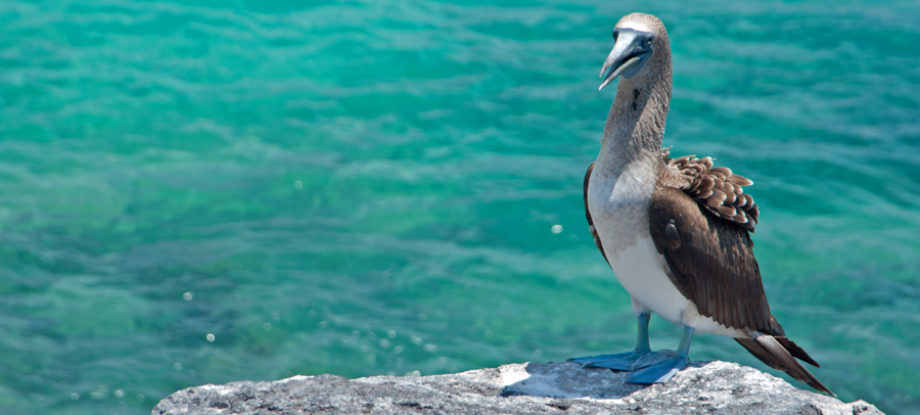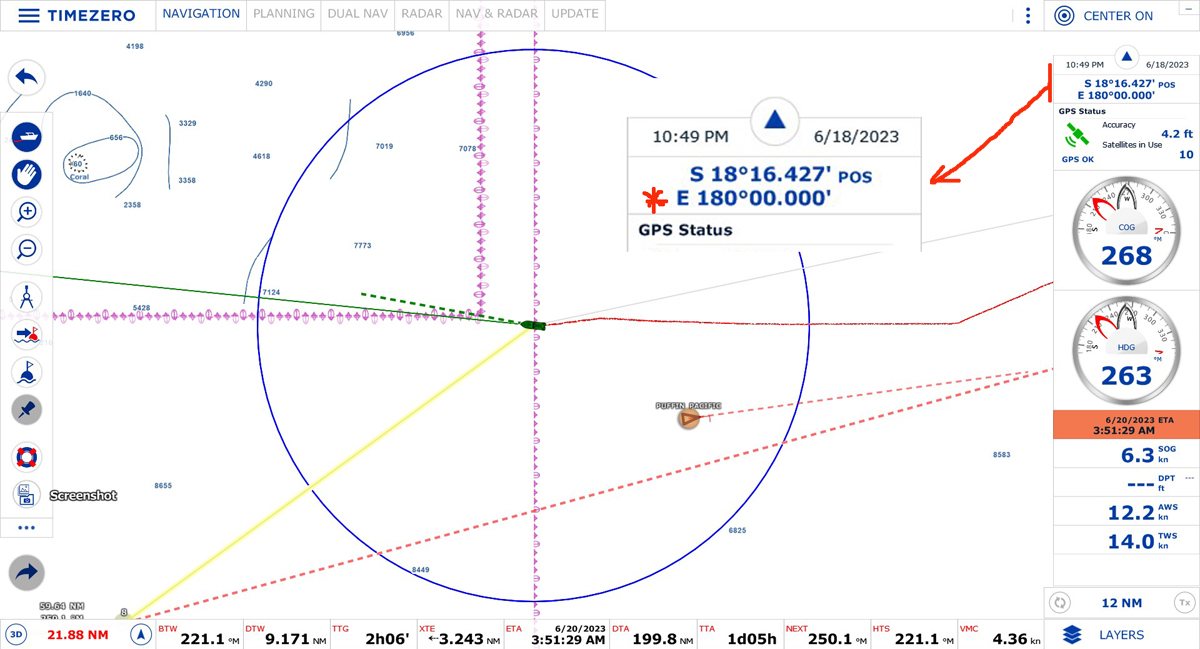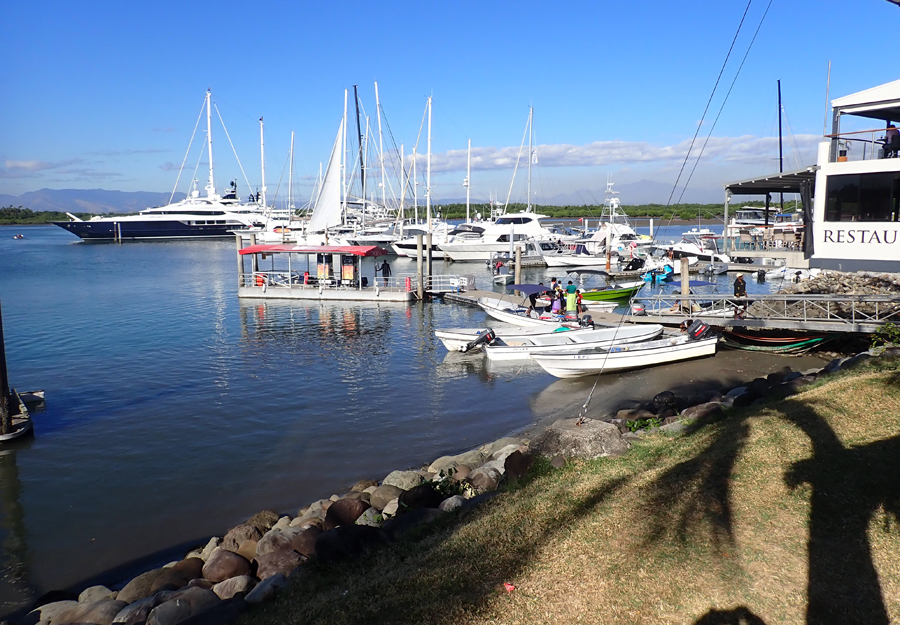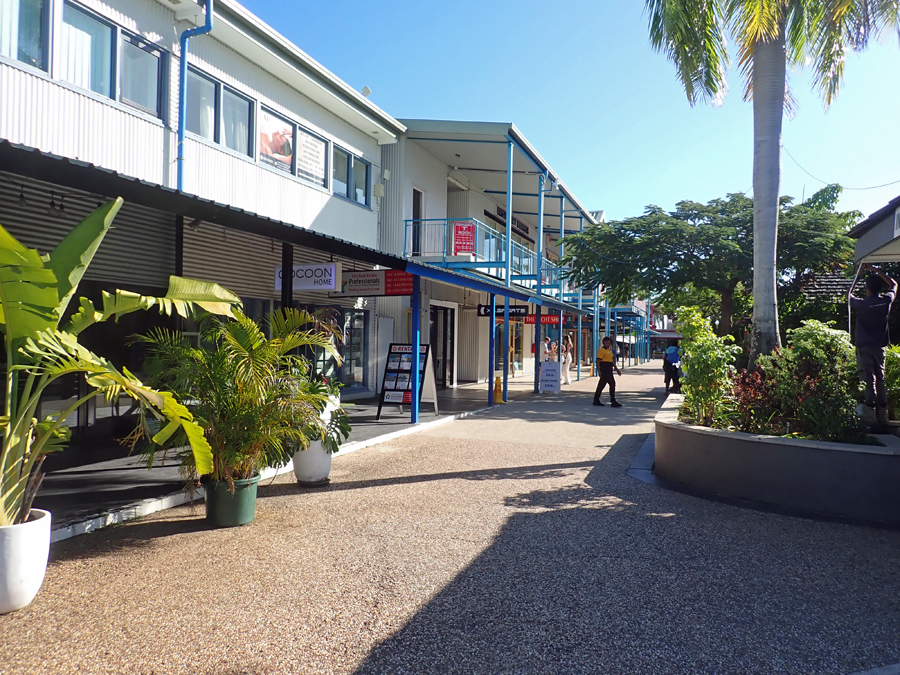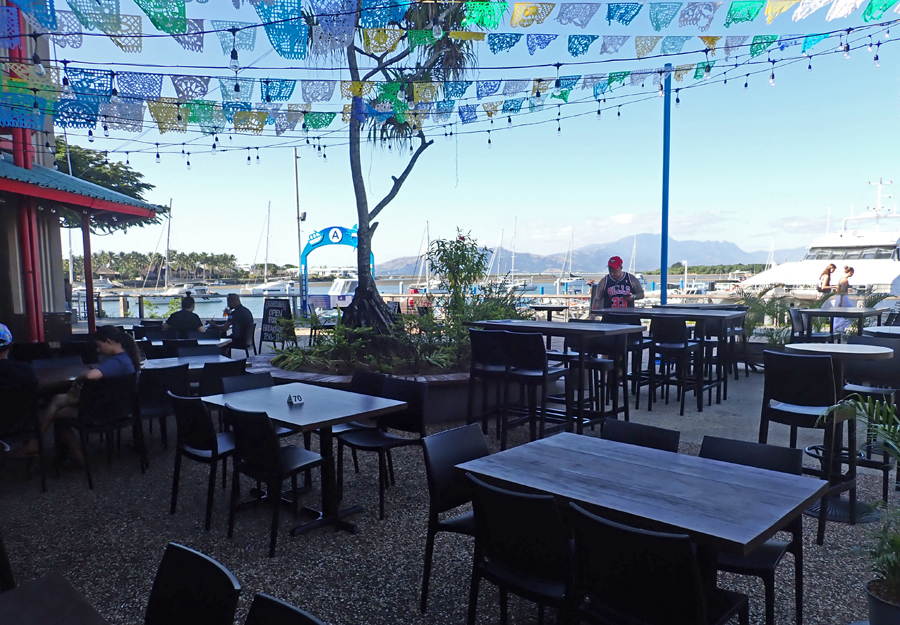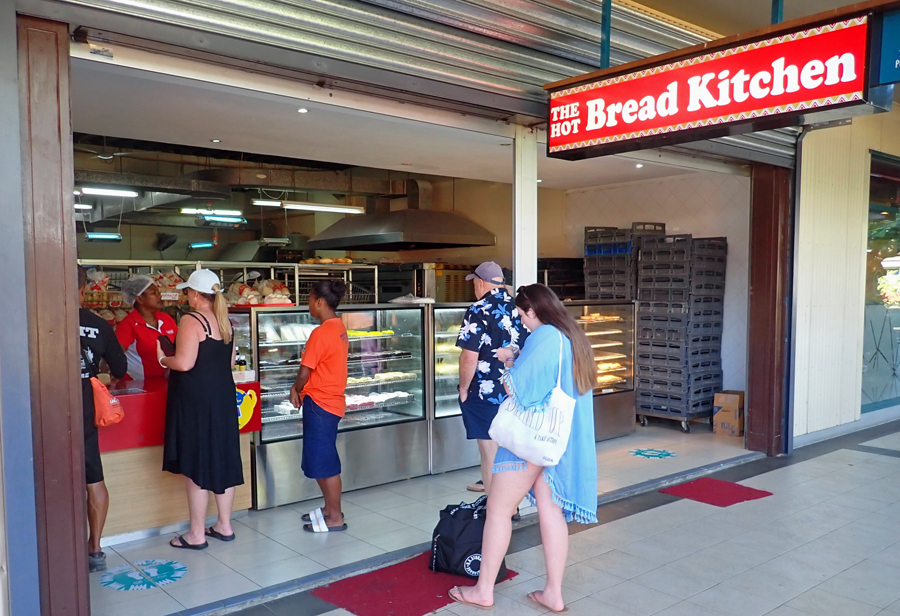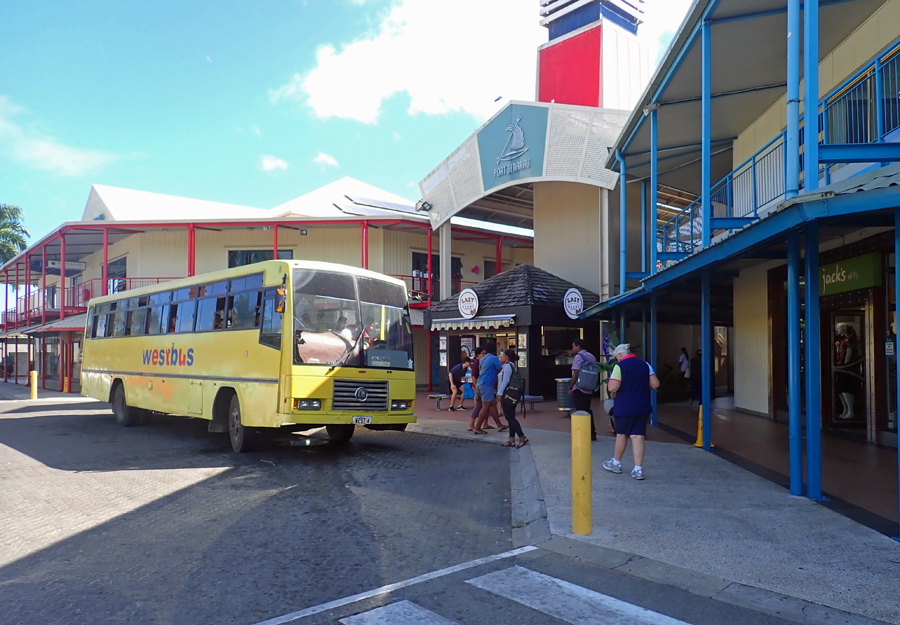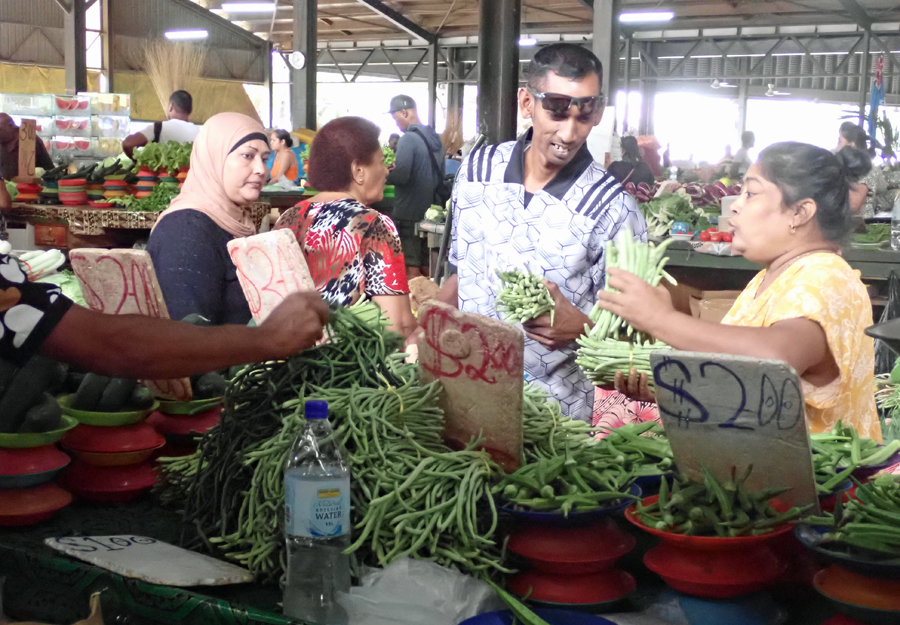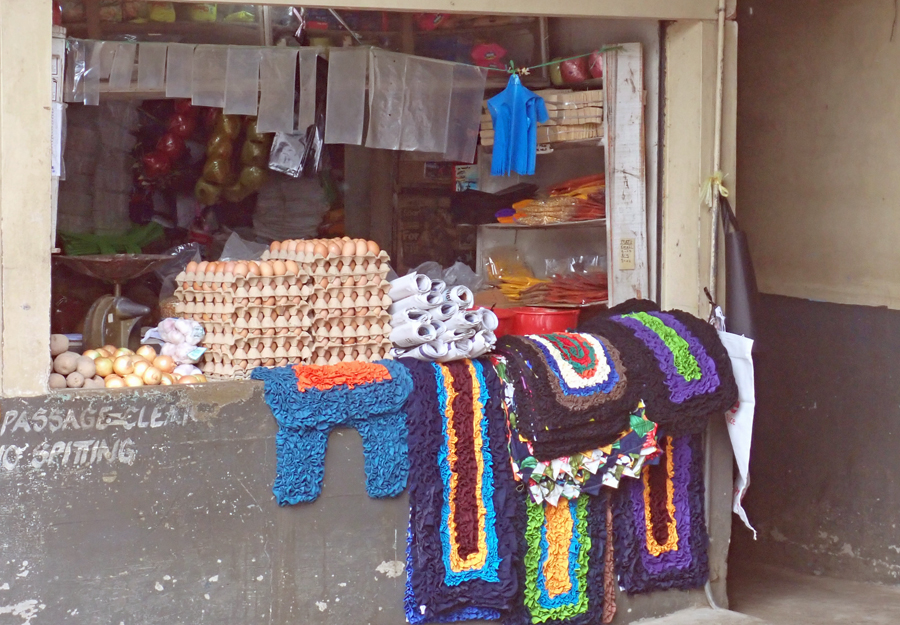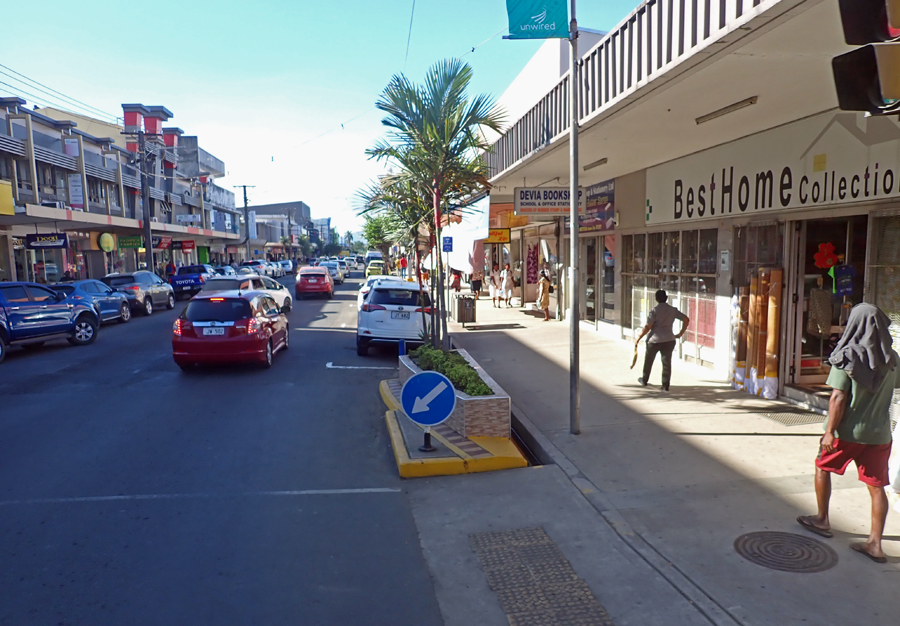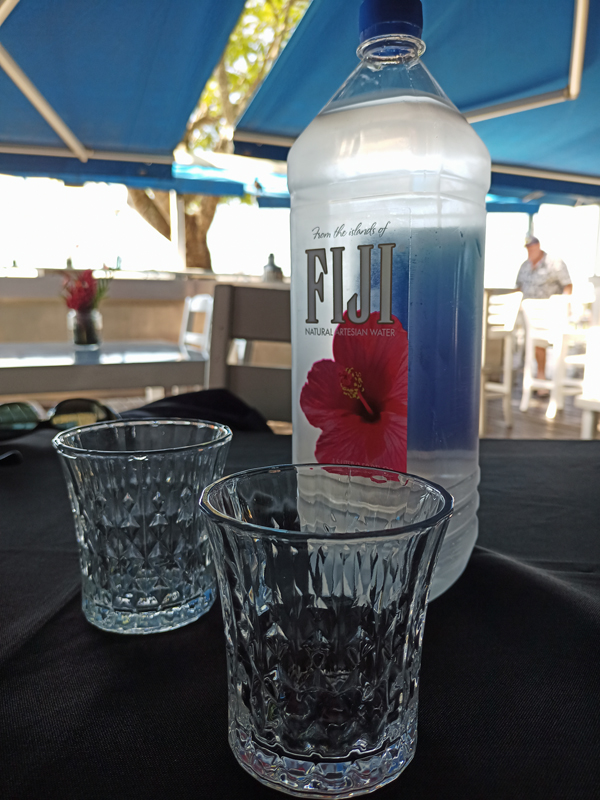On the way to Fiji, we crossed the Anti-meridian line also known as the International Date Line (IDL). This completes the 4th hemisphere for us and the Puffster. We crossed the equator from the northern to the southern hemisphere on our way to Galapagos. And, now we have crossed from the western hemisphere to the eastern. When doing this, it reminded me of a really interesting story I once read.
A captain once gave his passengers an experience of the century by parking his vessel on the IDL and the Equator at the same time:
The forward part of the ship was in the Southern Hemisphere and in the middle of summer. The rear part of the ship was in the Northern Hemisphere and in the middle of winter. Half of the ship was on 30 December 1899, while the forward half skipped a day ahead and into 1 January 1900.
This ship was therefore not only in two different days, two different months, two different years, two different seasons and two different hemispheres but also in two different centuries all at the same time.
You can read the full story here.
They speak English here! Oh, thank goodness. We are finally able to converse with local people without us dependent on them being bilingual. This is the first time we’ve been in an English-speaking country for about 6 years. Being able to read a menu without Google translate or being able to converse with staff at stores or businesses is something we’ll never take for granted again. We can actually understand signs, advertisements, and posters. Such a treat, yay!
Our check-in process was straightforward. The boat was visited by three officials; customs, immigration, and bio-control. Cindy always hands out cold drinks. These are a hit. The immigration officer loved our Mango juice and asked for more. The officials became friendly and chatty. Cindy takes care of all the official paperwork and officials. She is a stickler for following rules, of which here in Fiji there are plenty. Many other cruisers complain about having food items confiscated and being charged for incineration. Cindy made sure we ate anything that might be questioned during our journey here.
Once the officials departed the boat we went to the marina office to pay for our berth. We made arrangements ahead to have a slip in the marina available to us the entire season we are here. If you are a regular reader of the blog, you already know we don’t follow or travel like other cruisers. Because we have a slip, we already had a berth and a place to check in at, Port Denarau. Most cruisers check into the first Fiji entry port and work their way westward across the island chain. As I said, we’re not most cruisers. We blaze our own trail. Our thought and the current plan is to keep the boat slip the entire time we’re in Fiji and use it as a base coming and going as we please. When away, the marina can sublet it to another boat but it is ours when we return.
Our logic for doing this is after any passage, there are things we’ll need, small repairs to make, and a boat that really needs a good clean. We would much rather check in at a major island/port and have the amenities than hunt for things on a small outer island. Also, things like getting connected and buying SIM cards are much easier. Once here we can still sail anywhere in Fiji. So, why make things harder than they need to be?
Speaking of data, cell phone data, text, and minutes are dirt cheap here. We step up two phones with a pre-pay plan, one on each. This is the first time we’ve set up two phones in a very long time. Normally we can make do with just one and save a few dollars. But, as I said, the plans are very cheap. Both phones have more than we’ll ever use and we are under US$50 per month. Having local numbers really helps. We learned to do this years ago.
Denarau is a man-made island and a resort Mecca on the western side of Fiji’s main island, Viti Levu. There are tons of spa-type hotels, golf courses, shopping, and restaurants. The marina has some mega-yachts. One, in particular, caught my eye. It is a 47m (155’2) Perini Navi. Perini Navi’s are the Bentleys of sailboats. This one is stunning. And lil ol’ us, we are in the heart of all of it. It’s like being on vacation.
Our first stop after we departed the marina office and our very first steps on land after 15 days was for Mexican food. It has been eons since we ate Mexican food. French Polynesia had one quasi-Mexican restaurant. We avoided it after reading the tourist reviews on Tripadvisor. We both ordered chicken enchiladas and I was introduced to Fiji Gold beer. Yum! I think I’m gonna like it here.
We got the bill for the food and paid. I forgot to mention the customs guys let me run to the nearby ATM since there is a fee to check in here. This is where I withdraw FJ$1,000. I had no idea how much that is. It just seemed like a good round amount on the ATM and I had to pay the Customs guy FJ$200. Now we have a restaurant check to pay. We enjoyed an appetizer, drinks, and a main course each. The amount on the bill was once again foreign to me. I’m really going to have to figure out what the exchange rate is soon. The bill is FJ$99.00. It turns out to be about US$45 or 41€. Yep! I think I’m gonna like it here.
In the following few days, we tried several of the restaurants near us. There are about 20 within a short walk if you count the ones around the entire resort. We are close to the shopping complex built for the tourist staying at nearby resorts which houses 8-9 good restaurants. They have a hop-on hop-off bus that circles the island and stops at all the resorts allowing guests to come to this part of the island to dine and shop. Also, the marina is the hub for shuttle boats to resorts on outlying islands as well as marine sightseeing seeing excursions.
I have to say once again, how nice it is to be able to speak the local language. Ordering in English and being able to understand the waiter is a real treat. In the past couple of weeks, we have spent more on dining out here than I think we did for an entire past year in French Polynesia. It’s not that it is more expensive here. Completely the opposite is true. It’s because the food in French Polynesia was always mediocre, at best. We found a couple of good restaurants but they were not close by and our patronage was limited to days when we rented a car. Frankly speaking, we just got tired of paying exorbitantly high prices for not-so-great food and we unconsciously reduced our dining out. It wasn’t a matter of us not being able to afford to dine out in French Polynesia; it was truly so very rarely a good experience.
So far in Fiji, the food has been really good. We’ve finally, for the first time in 3 years, had a decent burger. The Mexican food was not what we’re used to but nonetheless good. We’ve had fish ‘n chips, pizza, Indian food, and are looking forward to trying authentic Fijian food all in the shopping center a few steps away. Here’s the best part, an open-front style bakery, The Hot Bread Kitchen.
Growing up in Oxford England, one of my favorite places was an open-front style bakery. It was located near the Westgate parking center and close to my bus stop. In these bakeries, everything is made on-site and throughout the day fresh loaves are stacked in the front cases. People passing by have a very hard time not smelling the fresh bread as it bakes in their huge ovens. This particular store was constantly busy. Either on the way in or out, I was always lured by the aroma and would treat myself to a loaf of cheese bread. It was sold still warm and was absolutely delicious. I’d never put anything on it. Just picking off pieces of the loaf and walking down the street, it didn’t last very long. On the rare occasion there was a little bit left, it was fed to the pigeons. It was this experience that led me later in life to learn how to bake my own bread since the USA seriously lacks decent bakeries. The French Islands and countries always have good bakeries and are a treat but, I wasn’t sure what to expect in Fiji. So happy to find this place.
We are now being spoiled with awesome chicken pies made with flakey pastry and fresh multigrain bread which is often still warm when we buy it. And last night as I was walking by, I couldn’t resist a small loaf of onion and cheese bread. Just like the old days. Most of it was gone when I got back to the boat. Along with a Fiji Gold beer, that could have been a very satisfying dinner.
Fiji mostly caters to tourism from Australia and New Zealand. It’s a pretty short flight for them and being English speaking and much less expensive than French Polynesia I bet also has some appeal. For us, this creates a problem. Australia, New Zealand and Fiji all drive on the left side of the road. We haven’t rented a car yet so that adventure remains untapped awaiting another day. However, walking on a sidewalk is challenging. If you meet people coming the other way and they are local, Aussies, or Kiwis, they tend to go to their left to pass us. However, there are a few Americans here. They are programmed to go to the right. We’ve been in French Poly for so long and it’s been quite a while since driving on the left (Grenada – I think), we tend to go right each time. This sometimes results in a little impromptu sidewalk dance.
Because we’re in the resort area among all the tourists, we are targeted. Taxi drivers especially hawk us as they are looking for fares. With us, they are barking up the wrong tree. Our first inquiry with a local person was regarding where does the bus stop. We are a short ride from the town of Nadi (pronounced: Nahn-di). Sometimes, just because I can speak the language, I’ll ask the taxi driver how much is the fare to Nadi. We’ve been quoted as much as FJ$30 (US$13.50, or 12.40 €) or as little as FJ$20 (US$9 or 8.30 €). The bus for the short jaunt, 7km (4.5 miles), to town is FJ$1.00 each. Guess how we get to town. The yellow bus! It is not really about the money. We like to submerge ourselves in local culture and bus riding is one good way.
We’ve read in the tourist guides to insist taxi drivers use the meter. Most like to quote a fare upfront and not run the meter. The guides say the rate quoted are negotiable if the meter is not used. The standard meter rate is FJ$1 per km. according to the Board of Tourism. So the ride to town should be quoted as only FJ$7. Yep, I can see why they don’t want to turn on the meter.
The yellow bus runs between the central bus station in Nadi and Denarau. While there are designated stops, this doesn’t mean much. The bus stops whenever someone waves for it and they get on. Or, if someone wishes to get off, they ring the bell. Ringing the bell is not high-tech. It is a piece of string over the windows connected to what sounds like a bell on the reception desk of a hotel lobby located above the driver’s head. This means the bus might stop at someone’s driveway, and then again at another driveway not more than 20 meters down the road. And, then again at a bus stop a few more meters away. And, so on.
On one trip to town, we saw the yellow bus at the designated stop near our shopping center. We needed to cross the parking lot to get to it and knew we’d not make it on time. So, rather than wait for the next bus, about 20-30 minutes, we stood on the road on the other side of the parking lot knowing the bus would need to go by us. We waved and hopped on. We’re quick learners of the local ways.
The yellow bus is about a step up from a carnival ride. On one trip, we sat directly behind the driver. I noticed not a single gauge worked on his dashboard. On another trip, the poor driver was having serious issues with the clutch and ground the gears every time he shifted. Yet another bus, one we haven’t yet had the pleasure of riding, has bad suspension on the left side and looks like it’s about to topple over. There’s no air-conditioning. A couple of seats can be broken. They are filthy inside. Not trash filthy but years and years of grime filthy. We generally try to avoid touching anything other than handholds. But hey, the price is right. And, they run just a few minutes apart. Most but not all of the buses in Fiji are this way.

The inside of the buses are covered with years of grime from having the windows open – not for germaphobes or cleanfreaks
For longer rides, we’ve read that buses can be quite luxurious. We’ve seen a couple of very posh buses on the road. These are for longer distances and they offer TV screens, reclining seats, and air-conditioning. As the buses age, it seems the strategy is to turn them into local buses. Perhaps this is so people don’t have to walk as far when they break down. I think the bottom of the ladder regarding bus life longevity is the yellow bus route. After this, it’s the junkyard.
The yellow bus is how the employees at the shops and hotels get onto the island and to their jobs on Denarau Island. We can often be the only tourists. It’s easy to immediately spot other tourists since they try to pay as they get on. The Fiji way is to pay the driver as you get off the bus. This brings me to my next point: The local people. I know I said some really nice things about local people in French Polynesia. Well, Fijians are the same. If not, they are friendlier than Polynesians which I didn’t think could be possible. They will easily strike up a conversation. Bula means hello. Sometimes it is said very enthusiastically. If a person makes eye contact, they will most definitely say, bula. It is considered very rude to not respond. So, let me give you an example of our experiences, so far. Keep reading.
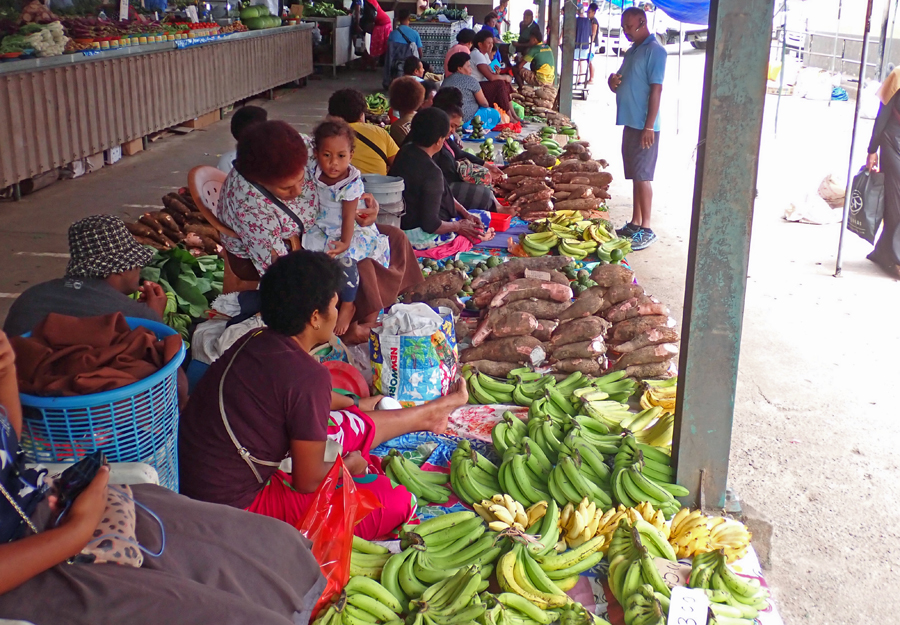
Every shady inch is used as a retail space. Those that don’t have a market stall work from a blanket on the ground
We made a run to town for the large hardware store to pick up a couple of items I need for some minor repairs to the boat. Finding the hardware store is as much of a priority as finding the grocery store when we arrive in a new port and country. Success, we managed to get most of the items on the list. I purchased a piece of wood for a project I have planned and it was a giant mystery about how we actually pay for it. Wood is sold separately from all the other stuff. Don’t ask me why. We never did figure it out and this time we speak the language so, no excuses. The sale for my single plank of wood involved (I’m not making this up) six people in various roles. This transaction could have been the entire storyline of a Seinfeld episode.
When it is time to catch the bus back, we are close to the bus station. On previous visits, we got off at the bus station but flagged the return bus on the main road. So, we are bus station virgins. The bus station was a challenge and very intimidating. There are signs for buses but it seems the bus parked in the spot is going somewhere other than where the sign indicates. Hmm! What to do. Oh yeah! We speak the language; we can ask someone without having to use Google translate.
Cindy makes eye contact with a lady who has correctly pegged us as lost tourists. The lady is waving at Cindy saying she can help us. Bula. She asked where we are trying to go. We say, Denarau Island Marina. She tells us to sit next to her and she’ll tell us when the next bus arrives. I keep an eager eye out for the yellow bus. We have a polite conversation regarding the usual questions about where we are from and how long we’ll be in Fiji. This is when we learn something new.
Apparently, the yellow bus run by the Westbus Company has competition. Sunset buses also run the exact same route. The Sunset bus, which is fittingly a sort of a red-orange color, parks near us at the bench upon which we are all seated. After a few minutes, the super friendly lady says, follow me because your bus has arrived. She walks us to the bus. I would like to point out that while she is walking us to the bus, she leaves all of her bags unattended on the bench. Wait, I say, this is not the yellow bus. She explains it runs the same route. The driver overhearing our conversation confirms. We thank the lady profusely for her help and she gives Cindy a kiss on the cheek and a quick hug saying she hopes we have a wonderful time here. Surprisingly, we don’t find this strange as Polynesian people love to hug and kiss. I guess it carried to Fiji.
Earlier that same day, as we walk on the main street in town a man walking next to me started a conversation. I have to say; sadly I’m still programmed to think this is not normal. Little red flags go up. He is just generally interested in where we came from and wanted to chat as we walked. So, we slowly walked and chatted. We reached his store and he wished us a pleasant day. Once in a while, we are reminded we are targets, but not this time. He was just a really friendly guy who told me Fiji people are happy because they drink Kava for breakfast, lunch, and dinner. Fiji kava is a traditional drink made from the dried roots of the kava plant. It has a long history of use in Fiji and other Pacific Islands. Kava is known for its relaxant and sedative effects. We haven’t tried it, yet.
I say we are targets. Once in a while a person will approach us and make conversation as it seems customary to do here. Then, comes the pitch. They want us to go to their store or are looking for a handout. It can become uncomfortable very quickly. I consider us seasoned travelers and have smart-aleck answers for obvious hawkers. When they ask where we’re from, my answer is usually, “back from that way” pointing to the direction we’ve just been without missing a step. Then, I’ll follow up with, “we’re heading that way” pointing to the way we’re walking. That’s usually enough to shake them off. Else, we’ll duck into a store wishing them a good day. Once in Grenada, we had to shake a guy by going into a store and sneaking out the side entrance. Later that day, he saw us again in town and just smiled that time.
I mentioned the buses don’t have air conditioning. This doesn’t matter. The weather here is much more tolerable and not nearly as hot as we expected. In the mornings, it’s darn chilly and I often see people wearing light coats. In Tahiti, we ran the air conditioning pretty much 24/7 when in the marina. Heat stroke is a very real concern. On the hook, we always needed to cool the boat at night with the AC. But here, we’ve hardly needed air conditioning. The temperatures have been wonderful. We don’t sweat near as much. We can walk places without arriving looking like we just stepped out of the shower. Sitting outside at a restaurant is very comfortable so long as there is shade. I can actually wear the same shirt all day without needing a dry one at some point. Finally, a climate I find tolerable.
I have to remind myself it’s winter here. We won’t be here for the summer because Fiji sits smack-dab in the middle of the cyclone belt. Cyclones here are not rare in the summer months. So, I will have to just wonder about how hot and humid the summer really is. In French Polynesia, it was hard to tell the difference between summer and winter. It was just wet-hot or dry-hot. I wonder if the same is true here, or not.
The water in our marina is free. We hold 1,000 liters of freshwater in our tank about 264 US gals. With typical usage, showers, toilets, laundry, dishes, etc. this last us about a week. We don’t ever skimp on water since the cost is usually low at marinas or free if we make it ourselves from seawater using our water maker purifier thingamajig gismo. But, something occurred to me as I was topping off Cream Puffs water tank. Something rather intriguing. This is Fiji water.
Hear me out. Fiji water is expensive. I don’t mean our Fiji water. I mean your Fiji water. Even at Costco, America’s favorite discount warehouse club, Fiji water is US$24.99 for a 12 pack which totals 8 liters of water. This means, I could fit almost 124 cases of water purchased at Costco in Cream Puff’s water tank. You see where I’m going with this? That’s US$3,098.76 worth of water, and this is at Costco low prices. So, do you think we could fill up our tank here with free Fiji water and quickly sail to the USA and unload it? I could pawn it off as Fiji water. I wouldn’t be lying. And, you could pay me with $7 bills.
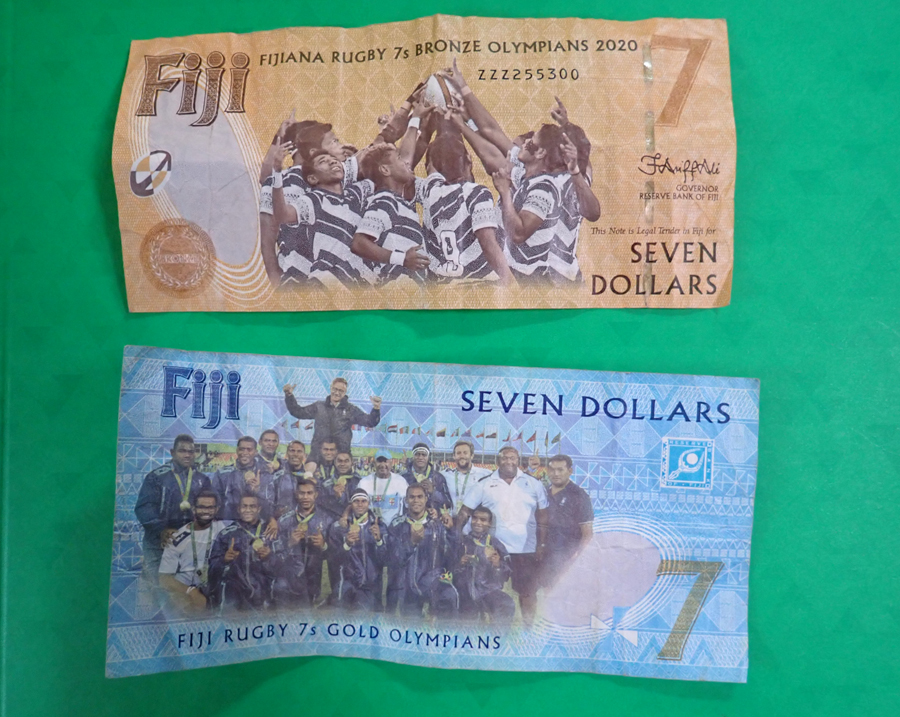
The only $7 currency notes in the world – each color celebrates a different win for the Olympic rugby team
So this brings me to something else that’s unusual. They have a FJ$7 bill here. I mean, how the heck does this make any sense whatsoever? After I was handed one, I thought this has to be some kind of a joke. Money is supposed to be like the metric system with denominations making sense and being easy to count. Sorry to my American friends, that quip went right over your head, didn’t it? I can already tell the shopkeepers don’t like seven-dollar bills. Like the USA’s two-dollar bill, there are not enough slots in the cash register for them. The cashiers sort of let out a small groan if you hand them one. And, they are quick to hand them to tourists telling them they make wonderful souvenirs. In other words, please get these things off our islands.
The truth behind the world’s only $7 banknote is, they were introduced in 2017 as a legal currency to celebrate Fiji’s win in Rugby 7’s during the 2016 Summer Olympics in Brazil beating the UK. This was Fiji’s first gold medal and first Olympic medal in any event, ever! It gets even better. They repeated as gold Olympic champions in the 2020 Summer Olympics in Tokyo, defeating New Zealand. Yes, New Zealand. But wait, there’s more! In Tokyo 2020, the women’s Rugby 7’s team also medaled bringing home the bronze. The gold bill has the men on one side and women on the other. I don’t think I have to tell you rugby is huge here. Seriously huge! So much so, they print money to celebrate it. How cool is that?
